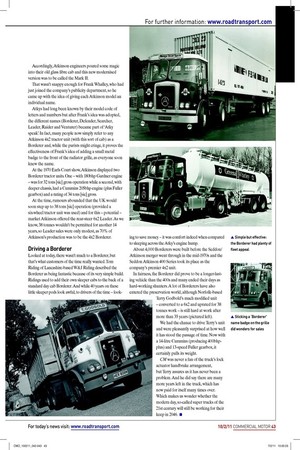Border line
Page 29

Page 30

If you've noticed an error in this article please click here to report it so we can fix it.
A touch of marketing genius gave a solid but staid slice of British engineering a much-needed boost in the early 1970s
Words/images: Bob Tuck Image, as most of us are aware, is paramount. Making your pitch to the market place can be a waste of money if your potential customers are not impressed with what they perceive they are buying.
In the late 1960s, there was no misconception with what Atkinson Vehicles of Lancashire built for the truck-buying world in their Walton-le-Dale factory. They may not have been the biggest UK producer, but Atkinsons were sold around the globe because the big ‘A’ badge denoted they were made from proven proprietary parts that – when looked after properly – could carry on working as long as you wanted.
Such a formula may have been enough to ill the company order book during the ’40s and ’50s, but during the swinging ’60s the Atkinson star was on the wane. The marketplace was being illed with bigger trucks offering more power – and a lot more glitz – and Atkinson was almost powerless to stop its market share slipping away. Rumours abounded it was going to be taken over (or at least merged) with a bigger truck builder. And while the UK’s fast-developing motorway age demanded that Atkinson should invest in a new range of models capable of a swifter pace, there was little in reserve to allow for such expenditure.
However, there was enough in the budget to employ a new publicity manager. And in hindsight, it was clear that, Frank Whalley’s new slant on marketing gave Atkinson a fresh bounce during the early 1970s.
Naming the family
A Gardner engine driving through a David Brown gearbox to a Kirkstall drive-axle had long been the requested Atkinson formula for many of the company’s devotees. The end users were never really bothered about frills to please the driver, but in 1958 Atkinson unveiled a stylish, modern-looking wrap-around cab across the entire range of rigids and artics. Maximum weight was 24 tons [sic] gross, and, while Atkinson tweaked the spec in the mid-1960s to allow for 32 tons [sic] gross with artics, by the end of that decade things were overdue for a revamp. Accordingly, Atkinson engineers poured some magic into their old glass ibre cab and this new modernised version was to be called the Mark II.
That wasn’t snappy enough for Frank Whalley, who had just joined the company’s publicity department, so he came up with the idea of giving each Atkinson model an individual name.
Atkys had long been known by their model code of letters and numbers but after Frank’s idea was adopted, the different names (Borderer, Defender, Searcher, Leader, Raider and Venturer) became part of ‘Atky speak’. In fact, many people now simply refer to any Atkinson 4x2 tractor unit (with this sort of cab) as a Borderer and, while the purists might cringe, it proves the effectiveness of Frank’s idea of adding a small metal badge to the front of the radiator grille, as everyone soon knew the name.
At the 1970 Earls Court show, Atkinson displayed two Borderer tractor units. One – with 180bhp Gardner engine – was for 32 tons [sic] gross operation while a second, with deeper chassis, had a Cummins 205bhp engine (plus Fuller gearbox) and a rating of 34 tons [sic] gross.
At the time, rumours abounded that the UK would soon step up to 38 tons [sic] operation (provided a six-wheel tractor unit was used) and for this – potential – market Atkinson offered the rear-steer 6x2 Leader. As we know, 38 tonnes wouldn’t be permitted for another 14 years, so Leader sales were only modest, as 70% of Atkinson’s production was to be the 4x2 Borderer.
Driving a Borderer
Looked at today, there wasn’t much to a Borderer, but that’s what customers of the time really wanted. Tom Riding of Lancashire-based W&J Riding described the Borderer as being fantastic because of its very simple build. Ridings used to add their own sleeper cabs to the back of a standard day cab Borderer. And while 40 years on these little sleeper pods look awful, to drivers of the time – look ing to save money – it was comfort indeed when compared to sleeping across the Atky’s engine hump.
About 4,000 Borderers were built before the Seddon/ Atkinson merger went through in the mid-1970s and the Seddon Atkinson 400 Series took its place as the company’s premier 4x2 unit.
In fairness, the Borderer did prove to be a longer-lasting vehicle than the 400s and many ended their days as hard-working shunters. A lot of Borderers have also entered the preservation world, although Norfolk-based Terry Godbold’s much modiied unit – converted to a 6x2 and uprated for 38 tonnes work – is still hard at work after more than 35 years (pictured left).
We had the chance to drive Terry’s unit and were pleasantly surprised at how well it has stood the passage of time. Now with a 14-litre Cummins (producing 400bhpplus) and 13-speed Fuller gearbox, it certainly pulls its weight.
CM was never a fan of the truck’s lock actuator handbrake arrangement, but Terry assures us it has never been a problem. And he did say there are many more years left in the truck, which has now paid for itself many times over. Which makes us wonder whether the modern day, so-called super trucks of the 21st century will still be working for their keep in 2046. ■





































